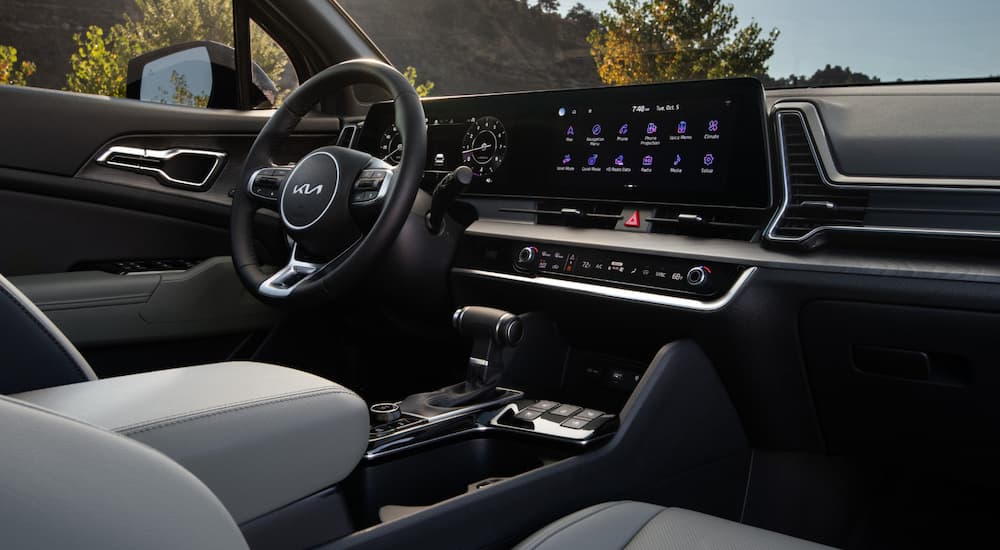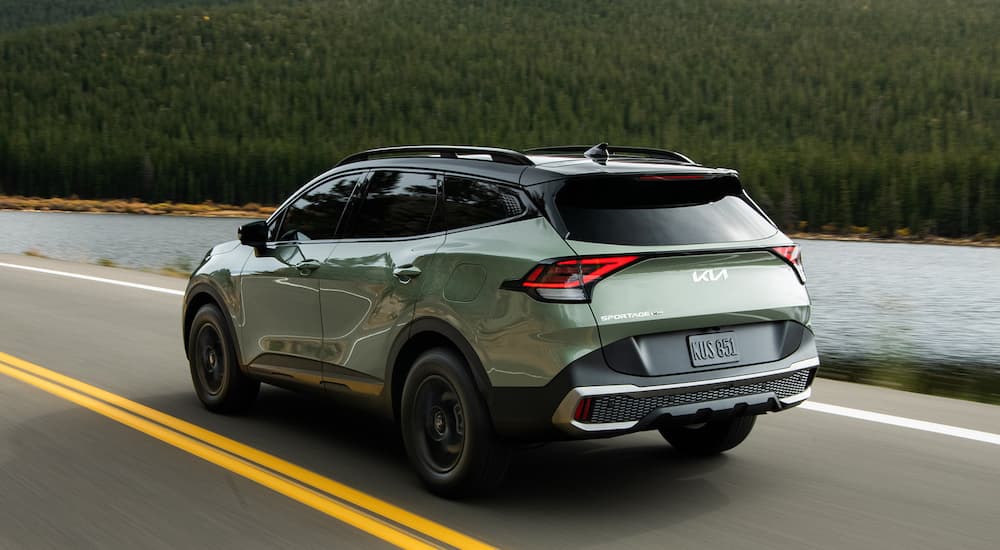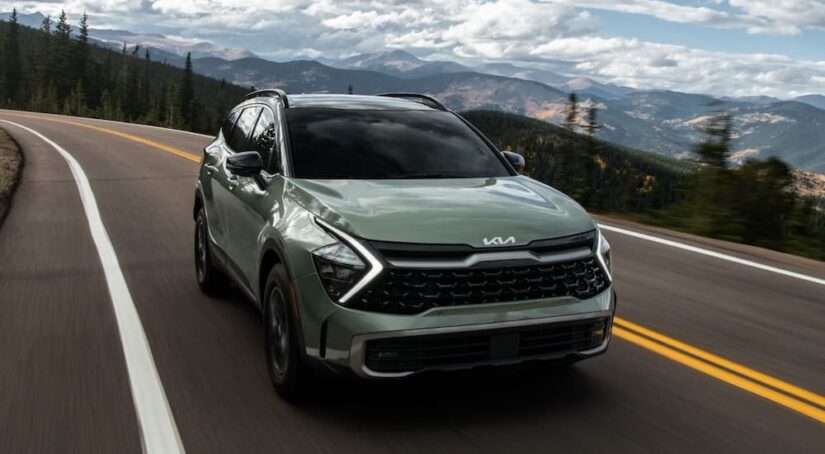Kia has been making a name for itself in the electrified space by offering a variety of powertrains beyond the traditional gas ones on several of its models. It does so on its Sorento, its Niro, and, of course, its Sportage. Many people already know that they love the Sportage as a whole. It’s a five-seater compact SUV with striking bodylines, smooth handling, solid towing figures and a comfortable interior. But no matter how much drivers understand the general concept of the Sportage, many still arrive at the Kia dealer unsure which powertrain to get: the traditional gas model, the hybrid (HEV), or the plug-in hybrid (PHEV).
These three powertrains offer a variety of ways for drivers to experience the Sportage. Not only do they offer very different fuel economy figures, but they can also come with different trim options and require different activities and systems when it comes to refueling or recharging. So, which one is right for you? Below, we’ll cover the main differences between the Sportage traditional gas model, HEV, and PHEV.
Powertrains and Fuel Economy
The first thing to consider is simply where you spend your days. This will impact which powertrain is right for you in terms of fuel economy and recharging/refueling needs. This might come as a surprise, but we’ll start with the plug-in hybrid, then the hybrid, and finally land at the traditional gas model to review the differences. It will become clear why when we’re finished. The PHEV combines the powers of a 1.6L turbo in-line engine with the hybrid capabilities of a 13.8 kWh motor. The PHEV maintains the energy it needs through three methods: traditional gas pumping, plug-in charging (either with your at-home charger or a public station), and regenerative braking.
The main advantage of the PHEV is its ability to run on electricity only. The EPA says the Sportage PHEV can drive about 34 miles on battery power alone. That’s not going to take you on any road trips and back, but if you don’t have time to fill up your gas tank, however, you do have battery power and an errand or two to run, you could get away with driving on battery power alone. The other advantage of the PHEV is the option to plug it in. While the HEV only captures battery power through regenerative braking (so you better hope you find yourself in at least some stop-and-go traffic), the PHEV can be recharged whenever you say so. Just plug it in. The PHEV also has the most impressive fuel economy figures, with the EPA giving it a combined figure of 84 MPGe.
Now, onto the Sportage HEV. It runs on a turbo hybrid powertrain and gets its energy from gasoline and battery power. However, you cannot plug it in. Any battery power will need to come from regenerative braking. While its fuel economy benefits from having a motor, it cannot run in an all-electric mode like the PHEV. Its battery just serves to boost the engine’s figures. But those figures are good. The EPA gives the Sportage HEV fuel economy figures of 42 MPG in the city and 44 MPG on the highway.
Finally, the gas model. Now, you can see that we started big and peeled away the powertrain complexities. At this point, you likely understand that the traditional gas engine has just a traditional gas engine. Naturally, its fuel economy drops quite a bit from the HEV and PHEV models. The EPA gives this model figures of 25 MPG in the city and 33 MPG on the highway.

A Closer Look at Trim Options
As you explore the trims of these three variants, you’ll notice some major discrepancies. The gas-model Sportage has the most trims, with a total of seven personalities to choose from. The PHEV and HEV models have more limited trim options. Ultimately, the increased efficiency you find with the PHEV and HEV models comes at the cost of having a narrow range of options to choose from.
The Gas-Powered Sportage Trims
The trim lineup for the traditional gas Sportage starts off with the LX, which gets you solid infotainment like an 8-inch touchscreen and smartphone compatibility, along with great driver assist features like a Rear-View Monitor, Lane Keep Assist, and a Rear Park Distance Warning. After the LX, you get the EX, which builds on the LX features with more luxury and convenience features, including heated front seats, driver lumbar support, wireless phone charging, and remote start.
Drivers looking for all-wheel drive will move up to the X-Line AWD. This builds on the EX trim, adding Active All-Wheel Drive, high-utility roof rails, an available Panoramic Sunroof, and an available Smart Power Tailgate. However, drivers can move in a more comfort and convenience-oriented direction with the SX, which builds on the EX, too, but in a different way. It adds a standard sunroof, a standard Smart Power Tailgate, a Harman Kardon audio system, a memory seat function for the driver, and interior ambient lighting.
Moving onto the upper trims, we get the SX-Prestige. This trim builds on the SX, getting you larger wheels, a Surround View Monitor, ventilated front seats, and a heated steering wheel. However, drivers who prefer what the X-Line AWD has to offer can check out the X-Pro trim. It adds more performance and luxury features to the X-Line AWD, including Center Locking Differential and Multi-Terrain Drive Modes, all-terrain tires, and Smart Cruise Control. Topping off the lineup is the X-Pro Prestige. Adding to the Sportage X-Pro, this trim gets you ventilated front seats, a power-adjustable front passenger seat, and a Blind-Spot View Monitor.
The Sportage HEV Trims
The HEV only has three trims: The LX, EX, and SX-Prestige; however, Kia makes up for the limited trims by making each one a slightly more souped-up version than its twin in the traditional gas model. For example, the HEV LX has all that the traditional gas one does and adds automatic rain-sensing windshield wipers and rear privacy glass. The EX has roof rails standard (they’re only available on the traditional gas EX) and adds a rear occupant alert. The SX-Prestige for the HEV adds Smart Cruise Control with Stop & Go and multi-color LED ambient interior lighting that the traditional gas model doesn’t get.
The Sportage PHEV Trims
The PHEV has only two trims: the X-Line and X-Line Prestige. For the PHEV, the X-Line has a Panoramic Sunroof with a Power Sunshade, a Smart Power Liftgate, a 12.3-inch touchscreen with navigation, a power driver seat, and a wireless phone charger. Meanwhile, the X-Line Prestige takes the X-Line features and adds a Harman Kardon premium audio system, a heated steering wheel, LED taillights and fog lights, and a ventilated front seat with a memory function for the driver.

Comparing Prices
The traditional gas model Sportage starts at $27,190, while the Sportage HEV starts at $28,590. Lastly, the Sportage PHEV starts at $39,590. As you can see, the PHEV sees a major price jump from the traditional gas model, whereas the difference in price between the traditional gas and HEV models is marginal. Considering that the only trims available for the Sportage PHEV are luxury trims and that it’s the only one that comes with charging technology, plus the ability to drive in all-electric mode, the price difference is justified.
Pick Out Your Kia Sportage Today
The best Sportage for you will depend on several factors; only you know which one best suits your lifestyle and budget. If you’re looking for the most affordable option with the most basic trim option, the traditional gas model will fit your needs. However, if you want the fuel economy boost a motor gets you while staying in the budget-friendly zone, consider the HEV. If you’re ready to spring for a luxury trim and want to enjoy the powers of plug-in technology, consider the Sportage PHEV. No matter which one you choose, you’ll be getting a sleek, comfortable, and safe compact SUV.



